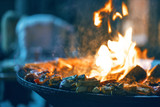Get to Know Your Grill
Most people who purchase a barbecue have no idea how it works. Does it matter? Barbecues are relatively simple machines, after all—gas produces a flame that cooks your food. But it is a machine. It has many working parts that, if not cleaned and maintained properly, can degrade and fail faster than they should. If you don’t understand the mechanics of the grill, purchasing a brand-new grill every time one breaks may be your only option.
However, knowing the basic mechanics of your grill and what to fix when it breaks can save you hundreds, maybe even thousands of dollars.
So, what makes up the anatomy of your grill?
Cooking Grates and Warming Racks
Anyone who’s ever stood in front of a barbecue knows what these are. All of your food, from beef, to chicken, to fish and beyond Is placed directly on these metal, stainless steel, or cast-iron grates. Because they take on the brunt of the heat, grease, smoke, and other elements, they tend to be the first to corrode, rust, or wear down. Luckily, they are easy and inexpensive to replace.
Burners
Burners are extremely important; without them, there’s nothing to produce a flame. You’ll find them directly under the cooking grate, evenly spaced for optimal cooking. Each one includes a line of small pin-size holes that can become clogged over time when not maintained. When this happens, you may get an inconsistent flame or no flame at all. Replacing these can be a little tricky, but well worth the time.
Heat Plates
Burners are occasionally paired with charcoal briquettes or heat plates, which not only help disperse heat evenly across the grilling surface but reduce flareups and protect the burners from excess grease and debris. These are easy to replace, just make sure you pay attention to the size before purchasing.
Control Knobs
On the outside face of your grill sit your controls knobs. Similar to a stove, control knobs help regulate the amount of gas and heat that gets pushed through each individual burner. Should any of the control knobs become damaged or stuck, it’s best to replace them as soon as possible so they do not become a hazard.
Igniter
To help get your flame started, you have the igniter, which you’ll find somewhere alongside the control knobs. This small button sends an electric spark to ignite the gas so you don’t risk singing your hand using a long lighter or match. Though it’s not as important to the overall cooking experience, when it breaks, it is relatively simple to replace.
Grease Tray
Under your grill sits this useful contraption. It’s there for nothing more than to collect excess grease and other byproducts that fall from the food you cook on the grill. This will need to be emptied and cleaned regularly so as not to overflow. Should it begin to rust or corrode, immediately find a replacement so it doesn’t lead to a fire hazard. (Yes, grease fires can happen outside).
Side Burners
Having a nice side burner to cook smaller foods, or foods that need a different temperature setting, is a nice addition to any grill. Regulated by their own burners and control knobs, they act as a secondary grill or warming plate. Should your side burner break or fail, swapping it out for a new one is much more cost effective than getting an entirely new grill.
Propane Tank Regulator
Finally, if you use a propane, you know about the tank that sits underneath the grill. Propane barbecues come with a regulator that reduces the pressure of the gas being pushed into the grill. When installing a new tank, make sure that the regulator is tight and that no leaks are occurring. If you do encounter leaks, turn off the propane tank and replace the regulator before doing any additional grilling.
When your barbecue breaks—and it will break—you can rely on DIY BBQ to supply you with some great replacement parts to get you back up and running without breaking the bank on a brand-new grill.
Recent Posts
-
2024 Barbecue Trends Every Grill Master Needs to Know
No matter what time of year it is, it’s never too early (or too late) to talk trends. After all, whe …Feb 22, 2024 -
Cook With Iron—Advantages and Disadvantages of Using Cast Iron on the Grill
Many wouldn’t think of ever using cast iron cookware on a grill. Isn’t capturing an open flame th …Feb 09, 2024 -
How to use smoking chips on a grill.
It's hard to beat the taste that grilling imparts upon meat, yet smoking chips take that flavor …Feb 08, 2024



